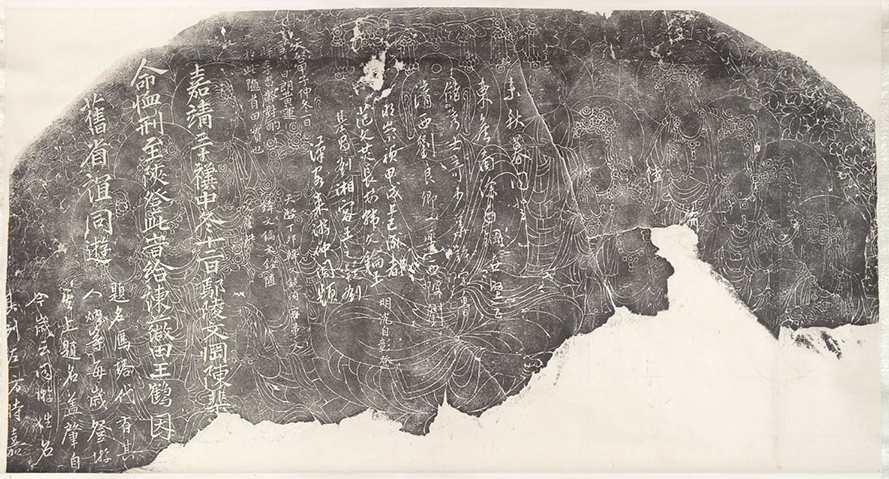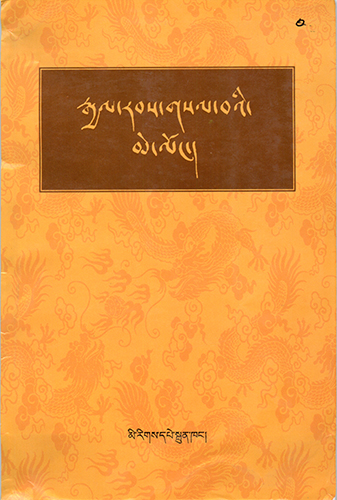Tag: BL Sino-Tibetan
Classical Chinese
The Languages of Berkeley: An Online Exhibition
題名雁塔代有其人
In every generation there are those who inscribe
their names on the Wild Goose Pagoda.
In 629, the Buddhist monk Xuanzang journeyed to the west in search of religious texts. Sixteen years later he returned to the Tang capital at Chang’an (modern Xi’an) with hundreds of Sanskrit sutras that would have to be rendered into Chinese. Emperor Gaozong invited the monk to base his translation project at the Big Wild Goose Pagoda on the grounds of Ci’ensi, a temple with strong ties to the throne and accordingly adorned with religious sculpture and textual engravings of the highest quality.
At that time, successful civil-service examinees were known to write their names on the pagoda walls with brush and ink. This custom evolved into something more durable in the centuries following the dynasty’s collapse in 907. Chang’an then lost its preeminence and much of its population, although it remained a site of historical and cultural interest. Visitors invariably stopped at the pagoda to view the surroundings from its upper stories. Some left their autographs there as well, carved over the Buddhas and divine attendants in the lintels surmounting the four entrances to the building—a practice that might have alluded to past privilege and accomplishment, but also to the city’s diminished status and the uncertain course of power.
This rubbing and dozens of others were given to the East Asian Library by the bequest of Woodbridge Bingham (1901–86), professor of history and founder of the Institute of East Asian Studies. Before the establishment of the East Asian Library, the campus community depended on faculty like Bingham, Ferdinand Lessing, and Delmer Brown, to help develop its collections: they left for sabbaticals abroad with lists of desiderata; once overseas, they sacrificed research hours haunting bookstores, searching out collectors willing to sell, wrangling with customs officials. At the end of their careers, many left their own collections to the university, building on the foundation that they had helped lay.
Contribution by Deborah Rudolph
Curator, C. V. Starr East Asian Library
Title: Dayan ta fo ke ji ti ming 大雁塔佛刻及題名
Title in English: Reliefs and inscriptions from the lintels of the Big Wild Goose Pagoda
Authors: Anonymous (artwork); multiple authors (textual inscriptions)
Imprint: 20th-century rubbing of Tang dynasty pictorial relief, with textual inscriptions dating from the Song through the Ming dynasties
Language: Chinese
Language Family: Sino-Tibetan
Source: C. V. Starr East Asian Library (UC Berkeley)
URL1: http://digitalassets.lib.berkeley.edu/stonerubbings/ucb/images/brk00024200_32b_k.jpg
URL2: http://digitalassets.lib.berkeley.edu/stonerubbings/ucb/images/brk00024198_32b_k.jpg
Other online editions:
- The East Asian Library’s rubbings of the lintels have been digitized and added to its online catalog of the rubbings collection, at http://www.lib.berkeley.edu/EAL/stone/index.html
- A series of photographs and details of the reliefs can be found on the blog site sina.com, at http://blog.sina.com.cn/s/blog_91ea73640102x92v.html (accessed 6/1/20)
The Languages of Berkeley is a dynamic online sequential exhibition celebrating the diversity of languages that have advanced research, teaching and learning at the University of California, Berkeley. It is made possible with support from the UC Berkeley Library and is co-sponsored by the Berkeley Language Center (BLC).
Follow The Languages of Berkeley!
Subscribe by email
Contact/Feedback
ucblib.link/languages
Tibetan
The Languages of Berkeley: An Online Exhibition
Rgyal rabs gsal ba’i me long is a famous historical work by Sakyapa Sonam Gyaltsen (1312-1375). The text presents Tibetan history such as the origins of the Tibetans, how dharma arrived in Tibet, when Lhasa became the main capital and the Jokhang and Ramoche temples were built. Sakyapa Sonam Gyaltsen was a ruler of Sakya which had a preeminent position in Tibet under the Yuan dynasty. He is considered the greatest Sakya scholar of the 14th century and served as ruler for a short term from 1344 to 1347.
According to McComas Taylor who authored the English translation, “It ranks among the great works of early Tibetan historiographical writing, but outshines all others in both the depth and breadth of its coverage. . . The text is a rich blend of history, legend, poetry, adventure and romance. It may properly be regarded as a literary work, albeit a morally and spiritually uplifting one.” He writes further: “This text has been known by several names. The original Tibetan title, and the one that is most widely recognized, is Clear Mirror on Royal Genealogy, although in the final paragraph the author himself calls the work Clear Mirror on the History of the Dharma. The first wood-block edition was printed at the Tsuglagkhang in 1478 and is therefore known as the Lhasa redaction.”
Ever since China annexed Tibet as a province in 1951, the Tibetan language has been proscribed in schools in favor of Mandarin.[1] Tibetan Buddhism and its literature are thus at present maintained by a worldwide diaspora, drawing some strength from Tibetan communities of the southern Himalaya beyond the Chinese border.[2] There are numerous (and mutually unintelligible dialects) of modern spoken Tibetan, and the study of these dialects — essential for the study of cultural practices such as pilgrimage — is becoming an area of research at several institutions, including UC Berkeley.[3] This historical text has been translated into Mongolian, German, and Chinese, and various sections have appeared in Italian and Russian.
Contribution by Susan Xue
Head, Information and Public Services &
Electronic Resources Librarian, C.V. Starr East Asian Library
Sources consulted:
- Garry, Jane, and Carl R. G. Rubino. Facts About the World’s Languages: An Encyclopedia of the World’s Major Languages, Past and Present. New York: H.W. Wilson, 2001.
- May, Stephen. Language and Minority Rights: Ethnicity, Nationalism and the Politics of Language. New York: Routledge, 2012.
- Institute for South Asia Studies, UC Berkeley
~~~~~~~~~~
Title: Rgyal rabs gsal ba’i me long
Title in English: Clear Mirror on Royal Genealogy
Author: Bsod-nams-rgyal-mtshan, Sakyapa Sonan Gyaltsen, 1312-1375.
Imprint: Pe cin: mi rigs dpe skrun khang, 2002.
Edition: Par gzhi 1
Language: Tibetan
Language Family: Sino-Tibetan
Source: Buddhist Digital Resource Center
URL: https://www.tbrc.org/#!rid=W00KG09730
Select print editions at Berkeley:
- Bsod-nams-rgyal-mtshan, Sakyapa Sonan Gyaltsen, and B I. Kuznet︠s︡ov, ed. Rgyal Rabs Gsal Baʼi Me Long: The Clear Mirror of Royal Genealogies ; Tibetan Text in Transliteration with an Introduction in English. Leiden: Brill, 1966.
- Bsod-nams-rgyal-mtshan, Sakyapa Sonan Gyaltsen. Translated into English by McComas Taylor, and Yuthok Choedak. The Clear Mirror: A Traditional Account of Tibet’s Golden Age. Ithaca, NY: Snow Lion Publications, 1996. Preview in Google Books.
- Bsod-nams-rgyal-mtshan, Sakyapa Sonan Gyaltsen. Translated into Chinese by Liqian Liu. Xizang Wang Tong Ji. Beijing Shi: Min zu chu ban she, 2000.
The Languages of Berkeley is a dynamic online sequential exhibition celebrating the diversity of languages that have advanced research, teaching and learning at the University of California, Berkeley. It is made possible with support from the UC Berkeley Library and is co-sponsored by the Berkeley Language Center (BLC).
Follow The Languages of Berkeley!
Subscribe by email
Contact/Feedback
ucblib.link/languages
Chinese
The Languages of Berkeley: An Online Exhibition

The concept of “children’s literature” was virtually foreign when Chao’s translation of Alice’s Adventures in Wonderland first appeared in China. Traditionally, children of the literate classes learned to read by memorizing and copying out primers, like the Three Character Classic 三字經, gradually moving on to the Confucian canon, dynastic histories, and standard compendia of classical literature. What fiction they read was written for adults.
This changed with the May Fourth Movement of 1919, which called for a number of reforms, including the use of vernacular, rather than classical, Chinese in all forms of writing. Some of the movement’s leaders further called for the development of a literature written for children, whether to free them of the intellectual constraints of traditional education, or to give them a psychological space of their own. First published in 1922, Chao’s translation of Alice can be viewed as an answer to both calls.
Alisi is not simply an historical artifact, however. As a linguist (albeit one who took degrees in mathematics and philosophy from Cornell and Harvard), Chao understood well the challenge of Carroll’s language—the puns, jingles, nonsense words of inexhaustible significance. How were these to be rendered in a written vernacular associated with any number of dialects, all abounding in homophones, linguistically and culturally unrelated to Victorian English? It is Chao’s solution to this challenge that continues to impress scholars and tickle readers almost a century after the book’s publication.
Chao joined the Berkeley faculty in 1947. By that time, Chinese had been a regular feature of the curriculum for fifty years, due to regent Edward Tompkins’ gift of the Agassiz professorship of East Asian Languages and Literature, the first chair endowed at the University. Tompkins’ primary motive in creating the chair was to benefit the state’s residents and its economy. He had seen trade developing between California and Asia, particularly China and Japan; but he knew that if it was to flourish, California businessmen must understand something of the language and culture of their Asian counterparts. Tompkins had a secondary motive as well. He had seen Asian students and scholars disembark at San Francisco only to board trains to the east, to established seats of learning. Tompkins wanted California, one day, to possess the same intellectual allure and pull. By Chao’s day, it clearly did.
Contribution by Deborah Rudolph
Curator, C. V. Starr East Asian Library
Title: Alisi man you qi jing ji(Search title 阿丽思漫游奇境记)
Title in English: Alice’s Adventures in Wonderland
Authors: Lewis Carroll; Yuen Ren Chao 趙元任 (trans.)
Imprint: Shanghai: Shanghai yin shu guan, 1939.
Edition: 4th
Language: Chinese
Language Family: Sino-Tibetan
Source: English-Chinese edition published in 1988 through the Library’s subscription to Chinamaxx (requires Adobe Flash).
URL: http://www.chinamaxx.net
Other online editions:
- Through Library’s subscription to Chinese Academic Digital Associate Library (CADAL) but requires free account creation and Flash).
- Yuen Ren Chao’s papers are housed in the University Archives at The Bancroft Library.
Select print editions at Berkeley:
The Languages of Berkeley is a dynamic online sequential exhibition celebrating the diversity of languages that have advanced research, teaching and learning at the University of California, Berkeley. It is made possible with support from the UC Berkeley Library and is co-sponsored by the Berkeley Language Center (BLC).
Follow The Languages of Berkeley!
Subscribe by email
Contact/Feedback
http://ucblib.link/languages

![The Languages of Berkeley [fan]](https://update.lib.berkeley.edu/wp-content/uploads/2019/02/fan_languages-450px.jpg)
